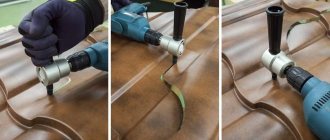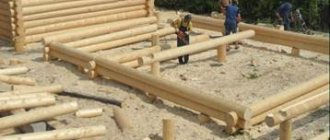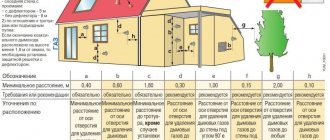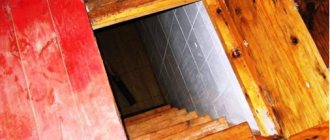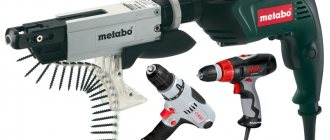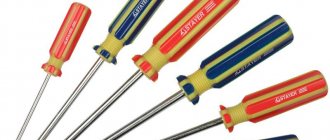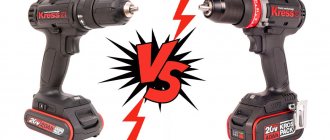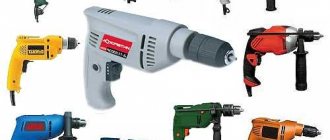One of the modern and popular types of tools is the renovator, which is also called a multitool or oscillator saw. What this device is, its types, operating features and other useful information can be found in this material. This article examines in detail the attachments for the renovator: what they are, for what purposes they are used, and other useful information for those who are just planning to buy this wonderful tool or have already purchased it and are mastering the technique of use.
Types of shanks on renovator attachments
Attachments, accessories or consumables for a tool such as a renovator have appeared on the shelves of construction stores relatively recently. And many buyers very often wonder what it is and what tool they are intended for. The attachments for the renovator really have a unique design, and are intended exclusively for this device (they are incompatible with other tools). It is contraindicated to use them for an angle grinder or any other tools. Firstly, since they are not suitable for the type of fastening, and secondly, the principle of their operation is based on the vibration effect created directly by the tool itself.
Equipment for renovators, unlike cutting discs for grinders or blades for jigsaws, functions due to vibrations. In even simpler terms, the cutting process is carried out through short movements of the cutting part, which are performed thanks to the special design of the renovator gearbox.
Modern manufacturers offer attachments for multitools designed for cutting wood, metal, drywall, ceramics, concrete, plastic and other materials. In addition, the renovator can be used not only for cutting materials, but also for grinding and polishing them. For this purpose, corresponding types of nozzles are also available. Most expensive tools are equipped with several types of such attachments.
Attachments tend to wear out, so depending on the frequency of use, you will soon need to buy them for your tool. And here it is important to take into account one very important feature - most of these products have universal fasteners, that is, they are suitable for tools from different manufacturers. It should be noted that there are models that are suitable for use only with certain types of devices (from the same manufacturer). They have a unique groove design and are therefore not compatible with other brands of renovators.
This is interesting! Although the cost of attachments for a renovator is not so high, and if you bought such devices and they do not fit your instrument, then do not rush to resell them or return them to the store. Especially for such cases, various adapters are produced that allow you to attach an attachment from any manufacturer to the tool. This is a very important feature, because consumables come in different qualities, and you always want to purchase the most reliable types of equipment from certain manufacturers, which may not always fit tools from other manufacturers.
Rating of renovators
Such a multifunctional device is always in demand, so the market is full of different models, brands, and varieties. The VyborExpert project team was helped to select clear leaders by the recommendations of the experts and their many years of experience, on the basis of which the main evaluation criteria were drawn up. Namely:
- Power type – mains, battery, both options;
- Autonomy – duration, charging speed, battery capacity;
- Power – for network 200-500, on battery 10-18 W;
- Oscillation frequency - the wider the range, the greater the possibilities;
- Setting – the ability to manually set the speed;
- Additional options - soft start, start blocking, indication, vacuum cleaner, etc.;
- Kit – number and types of attachments, accessories, storage case;
- Ergonomics – thoughtful design, ease of use;
- Dimensions – body dimensions, weight;
- Noise – sound pressure in the active state;
- Vibrations - the degree of load on the hands during operation.
Customer reviews showed not only the strengths, but also the weaknesses of branded products and new products from young companies. Based on this, the optimal offers were selected, differing in set, quality, functionality, and prices. The review included both budget and branded models for any budget.
The best polishing machines
Types of attachment attachments and what they affect
For renovators, nozzles are available in different types. First of all, you need to pay attention to the tail section or seat. They can be of the following types:
- The classic version is the most common type of attachments, which are characterized by reliable fixation, but at the same time have one drawback.
It manifests itself in the fact that the attachment cannot be secured in tools with a quick-release fastening method, with the exception of the Star Lock version used in Bosch brand renovators. - With a cutout - it greatly simplifies the change of products, because even when using devices with a screw fixation method, the need to completely unscrew the screw is eliminated. Nozzles of this type are very popular. The possibility of the attachment jumping out of the tool spindle is excluded, and depends on the quality of clamping by the clamping mechanism.
- With an additional hole on the attachment - this hole is designed specifically so that the attachment can be secured in the tool spindle with a quick-release fastening method, or in screw devices, eliminating the need to unscrew the screw. The disadvantage of such designs is that the diameter of the hole is sometimes smaller than the fastening part of the tool, and therefore, to secure the attachment, you have to unscrew the mounting screw.
These are the main types of fastening structures on attachments for renovators. It is also important to note another important detail that is implemented on such devices. Thanks to the large number of additional recesses, it is possible to fix the attachment in the tool spindle at the required angle, which greatly simplifies the performance of the relevant work.
This is interesting! Products from Fein, Rockwell and Craftsman only have 8 possible positions in which the attachment can be attached. For other products this value is 12, which is more convenient.
Buying Tips
The choice of a multi-tool depends little on its class and comes down to consumables and equipment. For your home, it is quite possible to buy a household appliance without a kit and select accessories for it only for the planned types of work. If you do not overload the equipment, it will serve no worse than professional ones. And consumables from top manufacturers are becoming practically immortal for home use.
The most popular professional tools and accessories are made by Bosch, Makita, DeWalt, Dremel and Fein. Among inexpensive brands, Renovator, Intertool, Enkor and Rhythm devices are popular. Knives and saws for the home should be chosen with the “BiM” marking as the most universal.
Varieties of saw attachments for wood for the renovator
Let's start our review of renovator attachments with products designed for working with wood. After all, it is this material that the tool copes best with, and is often used specifically for wood processing. To work with this material, manufacturers produce equipment of different designs in shape, tooth sizes, thickness and other parameters.
Based on appearance or shape, nozzles for renovators are classified into the following types:
- Straight type - designed for end cutting of wood, as well as cutting out various grooves and holes.
- Disc wheels are very similar to grinder wheels, but differ not only in the size of the teeth, but also in the design of the fastening part. They are intended for direct cutting of wood.
- Semi-disc - have the shape of a disk with a cut side. This shape of the products allows them to be used for sawing wooden surfaces or products with right angles. The most common use of such devices is cutting laminate flooring located next to a wall where there is a right angle, and it is not possible to use a disk attachment.
If you have acquired a renovator, then to unlock its full potential, you need to acquire different types of equipment. The products also differ according to one more criterion - the way the blade is positioned in relation to the spindle. They come in straight types, that is, when the disk or attachment has a flat plane, as well as curved ones. Products of the straight type are shown above, and the photo below shows a nozzle with a curved shape of the fastening part.
The bending angle varies and can reach 15 mm. This design of the equipment was developed specifically to improve the ease of use. This occurs when work is carried out flush with the surface, and the fastening mechanism of the tool does not interfere with or damage the surface being processed.
This is interesting! Due to the bending of the nozzle, its strength is reduced, but at the same time the ease of use increases, which is especially important when cutting the material flush.
Reviews of renovators from different manufacturers
Many reviews about renovators are very negative. A considerable number of users write about its unreliability and fairly frequent breakdowns .
They also write that attachments often break, and their acquisition is problematic. Most likely, these negative opinions are associated with a large number of fakes. If you buy a good and high-quality renovator, then it will cope with its responsibilities 100%. After all, we must take into account that the mechanism of the tool is not designed for long-term work; it cannot cut through cubes of forest. Positive reviews are written by people who bought professional models. The rating of renovators Bosch, Makita and Aeg can be seen in the video.
Sources
- https://instrument.guru/elektro/opisanie-renovatora-i-rekomendatsii-po-vyboru-ustrojstva.html
- https://stroi-specialist.ru/instrument/mexanicheskij-instrument/mnogofunkcionalnyj-instrument-renovator.html
- https://tehnika.expert/dlya-remonta/prochaya-stroitelnaya-texnika/nasadki-dlya-renovatora.html
- https://proinstrumentinfo.ru/nasadki-dlya-renovatora-nabor-37-nasadok/
Saw blades for wood for the renovator: differences in the shape of the teeth and what they affect
The market for consumables for renovators offers a wide variety of them. One of the important parts of equipment for cutting wood is its cutting part. It is presented in the form of teeth, which come in different sizes, and also differ in the presence of setting or its absence.
Initially, we will pay attention to the issue of the operation features of saw blades for renovators, which have medium-sized teeth of a straight shape and without setting
. Their main advantage is the ability to obtain a thin and accurate cut, but the disadvantage is that the products have low productivity and are not suitable for large volumes of work.
Looking at such devices, you will notice that straight-type nozzles have smooth triangular teeth, the length of which does not exceed 1 mm. The thickness of the blades is 0.8 mm, which has a positive effect not only on the quality of the cut, but also on the speed. At the ends of the teeth of round-shaped attachments there may be a edging designed to facilitate the process of sawing the material.
Now let's look at what kind of cut can be obtained using the appropriate type of attachments. For example, a pine board is used.
As you can see from the photo, the cut on the outer surface is clean without the slightest chips or other defects. The inner part naturally has chips, so before using the equipment, it is important to determine which side of the material being cut will be the front side.
Now let's look at the features of the functioning of saw blades for renovators, the teeth of which are set
. Due to this design, the cutting width increases, but at the same time eliminates the possibility of the nozzle jamming during work. Such devices are effective when a renovator needs to cut thick wood.
The tooth spacing on the nozzles varies. This can be a standard method of divorce, which is characterized by alternately placing them in different directions with passing through one. There are also nozzles that have a “group spread” and “wave spread”. How they differ can be seen in the photo below.
The use of such blades is justified when it is necessary to cut thick wood, and the quality of the cut is not as important as in the first case. The actual appearance of the saw blade teeth for a renovator with teeth set is shown in the photo below.
How this type of tool shows itself in operation can be seen in the photo below.
Now let's move on to considering attachments for the renovator with a “Japanese tooth”.
They are considered one of the most highly efficient and productive equipment, and are in great demand. Let's take a closer look at why this happens.
Japanese tooth attachments are easy to distinguish from previous options. The teeth not only have a large height of about 2-3 mm, but also have a characteristic sharpening.
Among the advantages of such equipment, it should be noted the high speed of operation, which is actually achieved by the large height of the teeth. In addition, the cut is of quite high quality, and no worse than that of previous products. It is worth noting only one important feature - it is recommended to use such consumables only when sawing soft wood. If you try to saw through hard wood, you may end up missing a few teeth.
It is recommended to use nozzles of this type; then a large amount of work remains. Again, it is important to note that the renovator is not able to replace a jigsaw or chainsaw, so this type of tool must be used responsibly.
This is interesting! Unlike previous options, the blade with the Japanese tooth shape cuts only in one direction. And at the same time the cutting speed is quite high.
On the shelves of hardware stores there are also attachments for renovators, which have oblique teeth. Such devices are also designed for sawing wood, although the outward design is very similar to the shape of the teeth, as on blades for metal. The products are characterized by low sawing speed, but at the same time provide high-quality cuts. In addition, they can also be used on plastic and drywall.
Summing up the use of wood saw blades for renovators, it should be noted that they must be selected depending on the technological tasks set. If it is necessary to obtain an even cut, you should use attachments with a small tooth without setting. If it is necessary to cut thick wood, and the quality of the cut does not play a big role, then it is better to use attachments with large and high teeth that have a set.
Manufacturers of consumables for power tools not only modernize their products, but also develop new products. For a multitool, you can purchase equipment that has the shape of a slingshot.
Such devices are similar in design to bow saws. They are intended for cutting wood of small thickness. The thickness is limited by the size of the blades attached to the nozzle. Unlike standard end-type devices, they are characterized by a high speed of achieving the assigned tasks.
Attachments for renovator for ceramics and concrete: tool effectiveness
The renovator can be used not only to work with wood materials, but also ceramics, tiles, glass, concrete, brick, etc. For this purpose, special cloths with an abrasive coating or spraying are used. They are also presented in different designs, which was done specifically for the convenience of carrying out the relevant work.
The main feature of these types of equipment is the presence of special spraying. Carbide materials such as diamond are used as such coating, and others will also be used. Not only the cost of the equipment, but also the efficiency of the work depends on the type of material used for spraying. That is why, when manipulating durable products, you should choose more reliable attachments.
The layer of carbide coating on the nozzle can be different, which affects the thickness of the cut, as well as the speed of achieving a positive result. It is worth noting that although the discs are designed for cutting ceramic tiles and other similar products, they are extremely difficult to cope with this task. If such a need arises, then it is necessary to cut ceramic tiles not along the front side, but from the back side.
At the same time, the efficiency of using the tool will increase several times. However, in any case, we should not forget that the renovator is only an auxiliary tool, and if it is necessary to process ceramic tiles in large volumes, it is recommended to use special tools.
In addition to ceramics, carbide-coated bits are used for cutting concrete. However, it will not be possible to cut concrete as effectively and quickly as when using a grinder. If you need to make a groove in a brick or a groove in a wall made of foam concrete, use a multifunctional tool.
This is interesting! Renovator for cutting concrete is used when it is necessary to complete the task without dust. After all, this tool, due to its special operating principle, allows you to achieve your goal without noise and dust (when compared with an angle grinder).
If you need to cut a brick or a layer of concrete, it is important to understand that to achieve the result you must use a nozzle of the appropriate length. The width of the equipment is indicated on the equipment. Manufacturers of carbide-coated renovator attachments recommend using them to perform tasks such as cleaning ceramic tile joints. The tool copes with this task better than any other device.
Summarizing what has been said about attachments for concrete and ceramics for renovators, it is worth noting that we should not forget about the purpose of the tool. Just as the device itself is not intended for long-term use, neither are the attachments. If you work with the equipment for a long time, it will begin to overheat, which will lead to chipping of the carbide coating. The result of such use is failure of the instrument and damage to consumables. Diamond-coated bits are quite expensive, so it is important to use them only when other tools are useless for the task.
Device Description
This device has a large number of names, but most often it is called a renovator.
Actually, that’s what this tool was called in advertising, but professional craftsmen claim that it would be correctly called a multi-cutter, or MFI for short (multifunctional tool) .
Today, such tools are produced by world-famous companies: AEG, DeWalt, BOSCH, Makita, etc. The main direction of the multi-cutter is to perform restoration and finishing work. It’s worth noting right away that the renovator is useless for thorough finishing and construction work.
Small amplitude vibration was first used in 1968 in a small saw used to cut plaster casts. Later they began to use them for plumbing work, and there were no attachments then. At the very beginning of the 80s, they began to produce devices with attachments that could be changed.
Design and principle of operation of a multifunctional tool
Let's talk about this first of all. Because many not very fair critics of the instrument, not understanding this very principle, claim that the design of the device itself provokes its rapid failure.
It is quite difficult for a non-specialist to understand this almost X-ray image of a renovator, but anyone will notice that the main unit in it is the same electric motor as in most hand-held power tools comparable to it. So, at the end of the output shaft of this electric motor there is an eccentric, which, through a fork, transmits oscillatory movements to the working head of the renovator. This, practically the only loaded unit, is completely lubricated with grease, which provides for a fairly long service life.
As you can see, something that was not originally intended for long-term use can quickly break down here. And it could be a tool from a disgusting manufacturer. But they began to produce it both from large manufacturers of similar equipment and from numerous Chinese garage cooperatives, which sometimes do not even put a label on their products. Therefore, you need to approach the choice of a renovator wisely.
What is the purpose of the renovator?
- Cut a small block or small plank.
- You can trim the nail that is in the way.
- Sand a small surface area.
- Cut off the PVC pipe.
- Clean the seams between the tiles.
- Remove old paint.
And this is not the most complete list of functions that can be performed using this device. The variety of attachments will allow the tool to solve as many problems as possible related to minor repairs, as well as the ability to work in hard-to-reach places.
Types of work performed using a renovator
First of all, this tool is intended for the mechanization of a large number of small, auxiliary jobs around the house. It is almost indispensable for finishing and working in hard-to-reach places on small surface areas.
Using it to cut reinforcement or split large-section wood to great lengths is the height of stupidity.
What a renovator can do and what it is intended for:
1. Provide assistance in removing old coverings of various types - carpet, linoleum, tiles, etc., remove silicone or sealant from the seams.
2. Cut holes of rectangular or any other polygonal shape in drywall, wood, fiberboard, chipboard, plastic and the same tile.
3. Perform a large number of cutting and trimming work in hard-to-reach places that are beyond the capabilities of any other tool.
4. Sand or polish surfaces, incl. in those hard-to-reach corners that cannot be treated with anything with such care.
5. Make perfect flush cuts, various kinds of cuts in soft (and sometimes not so soft, due to active wear of the nozzle) material with amazing cleanliness, which you cannot get when using other tools.
It is also worth mentioning the exceptional safety of this multifunctional tool. It is almost impossible for them to be injured.
In addition to networked renovators, of course, there are also battery versions of the tool, which makes it even more mobile to use.
It is precisely these specific types of work that either cannot be performed at all or are extremely difficult to perform with the help of another electric or manual tool, and all the arguments of his opponents are broken. And, I must say, there are many of them. First of all, because of manufacturers, who fill the market with clearly low-quality products (including attachments), and secondly, because of consumers who are trying to get from the tool something for which it is not intended.
How to choose a renovator?
Everyone who already owns this multifunctional tool cites the high cost of the attachments as its main disadvantage. One high-quality working attachment can cost as much as 1/3 of the tool itself, which already includes several of the same ones. Paradox? You might even think that the renovator itself is just a free add-on to its attachments. Of course this is not true. Simply, if you are offered a tool complete with a huge number of attachments for 3,000 rubles, then you should think about it.
Therefore, if you decide to purchase this multifunctional device, we recommend that you pay attention to companies that you trust unconditionally, and it is better to choose the minimum number of attachments.
Carbide coated concrete grinding attachments
The renovator can be used for concrete grinding work. For this purpose, manufacturers produce special types of equipment. They are also available in a variety of designs, which expands their scope of application.
Various types of abrasive materials are used as spraying, which are resistant to abrasion when processing concrete surfaces. Most often, nozzles of this type are used to remove residues of dried cement mortar or tile adhesive. With the help of such nozzles, the surface is prepared for laying tiles and other materials on a concrete base.
The nozzles have different sizes of carbide coating fractions, so when choosing them, the technological task at hand should also be taken into account. For finishing the surface, fine-grained equipment should be used, and if the task is roughing, then coarse-grained abrasives are used.
To summarize, it is necessary to note the importance of using such attachments. After all, with their help you can remove mortar from bricks or concrete surfaces, level and prepare the area for laying ceramic tiles and tiles. And all this becomes possible thanks to this type of tool, the renovator.
Handyman
Construction, installation and repair work involves processing surfaces of various types - wood, ceramics, metal, concrete, etc. The multifunctional renovator tool has no restrictions on use with any one material: thanks to the appropriate attachments, a full scope of work is available to a household or professional craftsman :
- cutting wood, plastic, soft metal;
- removing floor coverings;
- cutting and removing a thin layer of cement mortar;
- polishing of metal, stone and other hard surfaces is carried out using felt attachments of varying degrees of abrasiveness;
- cutting into materials of various kinds at small, medium and maximum depths for the nozzle;
- cutting drywall, cutting soft materials - rubber, carpeting, cardboard, insulation;
- scraping ceramic tiles, etc.
The equipment for this tool is made only from high-quality materials, and the configuration of a specific attachment depends on the profile of work and materials for which it is intended: the saw blade, in particular, has a segmented shape, the equipment for removing mortar is drop-shaped, sanding sheets for wood processing are deltoid shape. Often, manufacturers, in addition to individual units, offer a set of attachments: when purchasing such a set, you can be sure that when carrying out installation, repair or construction work, everything you need will be at hand.
Each nozzle has mounting holes, due to which it is tightly fixed on the hexagonal holder of the tool itself (nozzle sockets can be universal or specialized - only for tools from the same manufacturer). After installing the nozzle, the bolt with the spring washer securely fixed on it is tightened with a hex key. The last step of a fairly simple and quick installation will be to check the correct position of the nozzle and the reliability of its fixation.
Blades for grinding surfaces for renovator
Using the tool in question, you can also grind not only concrete surfaces, but also materials such as metal, wood and others. To implement such tasks, nozzles are used, which are presented in a wide variety. The principle of their use is similar to grinding equipment for drills and grinders. For this purpose, special backings with Velcro are used, onto which sandpaper is attached.
The principle of using such devices is quite simple. Having secured the substrate in the renovator spindle, you need to apply sandpaper to its surface and get to work. Depending on the type of processing and the material being processed, the appropriate grain size of paper is selected. Moreover, it can be presented in two versions:
- Solid - has the shape of a substrate.
- Perforated - has the shape of a substrate with holes, the main purpose of which is to improve dust removal during processing.
The substrates themselves are available in the following versions:
- triangular;
- round;
- in the form of an iron.
Below are photos of such attachments, as well as the corresponding types of abrasive skins for them. It is worth noting that you can purchase sandpaper of the appropriate shape for the renovator either as a set, which includes sheets of varying degrees of grain, or individually.
Such attachments are used for grinding various surfaces. The most common way to use them is to remove traces of corrosion on metal surfaces, such as a car body. Unlike an angle grinder, using a renovator for grinding has a number of advantages:
- Safety - when working with an angle grinder, due to the centrifugal force, the tool tends to be pulled out of your hands, so you need to hold it with both hands. Due to vibration movements, the renovator does not need such reliable fixation during processing.
- Quality - due to oscillatory movements, a higher quality surface treatment occurs than when grinding, performed with rotational movements at high speed.
- The ability to process hard-to-reach places - only a renovator can handle this task, because it is impossible to process corner parts with either an angle grinder or a standard eccentric sander.
A huge variety of types of sanding attachments for multitools opens up great opportunities for the master. Having various options for renovator substrates on hand, you can easily treat any (including hard-to-reach) surface areas. It is for such cases that attachments are used that have the form of a clamp, with which the sandpaper is fixed on both sides. The photo below shows the appearance of such equipment options.
They are designed specifically for grinding grooves of various types. The special configuration of such devices allows them to be used with maximum efficiency. They are especially relevant when it is necessary to polish the surface of old furniture or remove rust on parts that have an unusual shape.
Peculiarities
This tool works on the principle of transmitting the rotating force of an electric motor to a pendulum mechanism, which creates high-frequency oscillations - vibration of the working area. Mechanical energy is transferred using a special “fork” and an eccentric.
This technology allows you to extract sufficient efficiency from the tool without resorting to rotation of the working nozzle. The excess load that occurs during friction and leads to mechanical destructuring is removed from it.
The vibration-pendulum operating principle of the renovator assumes the presence of a high load exerted on the transmission mechanism. To compensate for its negative impact on the parts, the torque transmission unit is immersed in a special lubricant.
The main feature of this tool is the possibility of safe operation. Thanks to its special design, the working nozzle reacts to contact only with a hard surface (wood, metal, concrete, ceramics and others). Soft materials are not subject to vibration, which ensures a high level of safety when the nozzle comes into contact, for example, with parts of the human body. Even by accidentally touching the working area of the switched on device, the user will not receive destructive damage to soft tissues.
The versatility of the tool ensures the presence of a long list of replaceable attachments for various purposes and their interchangeability. Depending on the type of attachment, you can use the renovator to perform the following work:
- cutting wood, metal, ceramics and other materials;
- cutting closed holes in hard-to-reach places;
- cleaning surfaces and spaces;
- grinding;
- hollowing manipulations;
- other related work.
Quality and efficiency in terms of time and effort for the work performed depend on the correct selection of appropriate nozzles and their quality characteristics.
Renovator attachments for cleaning dirt and polishing
For the renovator, attachments in the form of abrasive sponges and felt bases are also available. The first type of product is intended for cleaning surfaces from various types of contaminants, and the second is used for polishing surfaces.
Using an abrasive sponge, you can carefully clean surfaces and remove rust, scale, varnish and epoxy resin. Felt polishing equipment is designed to produce smooth surfaces.
Which renovator is better
The tool should be selected primarily based on the criteria described in the rating. To understand which renovator is better to buy, the Vyborexperta.ru project conducted a comparative analysis and summed up the rating:
- DeWalt DCS355N 0 – low vibration, large set of attachments in the case;
- Bort BMW-12LI-FDK – renovator with two batteries and light indication;
- Endever Specter-3060 – lightest weight, display, convenient settings system;
- Bosch PMF 220 CE – high build quality, speed stabilization system;
- Ryobi R18MT-0 – rotating head with a large cutting angle, mains/battery power supply;
- Black+Decker MT300KA – unique fastening system, reliability, case with set;
- Elitech MI 500EK is a productive device with a vacuum cleaner and a cooling system.
In the list of named brands and models you can find only great deals - a compact lightweight device, a product with a huge range of attachments, inexpensive and functional new items. What to buy is decided taking into account how often the device will be used and what tasks to perform.
Scraper attachments for renovators: types and purpose
Another type of attachment for a multitool is scrapers. Outwardly, they are similar to attachments for wood processing, only they are thinner, and instead of teeth they have a sharp edge. The products are available in different shapes, which expands the scope of their application. The main purpose of such products is to remove paint and varnish from wood, metal and other surfaces.
With their help you can remove old glue, wallpaper, linoleum, roofing felt, roofing felt and other materials. Such consumables are very convenient and effective when cutting sealant and polyurethane foam. Manufacturers also produce a special type of renovator attachments, which are designed to perform dismantling work on automobile glass. Scrapers come in both straight and curved designs.
The optimal approach to choosing nozzles
Attachments for multifunctional tools bear the main load during operation, so their choice should be approached seriously and carefully. Usually one or another number of them is present in the kit of the renovator being sold, which can be mains or battery-powered. If the set of attachments sold at a reasonable price along with a multitool is too large, then this indicates the low quality of their manufacture. It is better to purchase a unit from a well-known brand with several main cutters, and then purchase those that you really need in your work. In this case, the design and execution of the part must correspond to the specific purpose and strength characteristics of the material being processed.
Do not be lazy to ask the seller for the accompanying documentation and make sure that the product has the appropriate markings.
Since renovator attachments operate in high-frequency vibration mode, they must be securely fixed in the fastening unit of the tool’s working head. For this purpose, its body has shaped cutouts, which may not be the same in shape for different manufacturers of multitools. You should definitely pay attention to this when purchasing. Fastening can be done using:
- hex wrench;
- special quick fixing clamp.
There are universal adapters that allow you to use products from different manufacturers. The differences between multitool attachments relate to the shape of the part, the base material and surface coatings used, and the design of the cutting edge. Their design is optimal for performing a strictly defined type of processing and, in most cases, allows you to work in inconvenient places or in cramped conditions. Along with the versatility of the tool, this is its main advantage.
Renovator blades for metal cutting
Manufacturers also produce equipment that is used for working with metal. The design of the equipment is very similar to products for cutting wood, and differs in the following parameters:
- has small teeth;
- There is a corresponding “Metal” marking, which indicates the possibility of working with metal.
The renovator, unlike the grinder, cuts steel much longer, so this tool is used for working with metal in exceptional cases. Such cases include sawing off protruding nails or fasteners, cutting sheet steel, and cutting steel, copper and aluminum pipes. With the help of a renovator, metal cutting is performed more accurately.
This is interesting! Metal sawing attachments can be used on wood, drywall and plastic.
The nozzle shown in the photo above has markings in the form of a ruler. It is used to control the degree of deepening of the web in the material. With its help you can cut grooves and holes with high precision.
Determining the purpose of the nozzles: what materials they are made of
There are many different attachments available for the renovator, which confirms the fact that this tool is called multifunctional. The only question remains - how not to get confused about the correct use of the appropriate attachments? Most types of equipment have the corresponding designation “Wood”, “Metal” or “Plastic”. Here it becomes clear what materials they are intended for processing. The features of the use of the corresponding nozzles can be determined by the material from which they are made:
- HCS - this designation on the equipment indicates that it is made of high-carbon steel, the hardness of which is 45-48 HRC. It is also called carbon steel, which is used for processing wood, plastic, chipboard and fiberboard materials.
- HSS is a high-speed steel that is designed to work with materials of increased hardness. These include soft steel, aluminum, copper and other types of non-ferrous metals. They differ from products marked HCS in that they are thinner, but at the same time their strength is many times higher.
- Bi-Metal - bimetallic versions of attachments are designed for processing wood and steel. Such products are obtained by using high-carbon HCS and high-speed HSS steels.
- Drywall - devices for working on drywall.
On the front part of the nozzle for renovators there may be other symbols, for example “Wood”, which is translated from English as “Tree”. If the equipment is marked “Hardwood”, then this indicates the possibility of using such devices for sawing solid materials made of wood and PVC.
To summarize, we should draw a conclusion about how to choose the right attachments for the renovator. First of all, you need to focus on your type of tool. When purchasing new consumables, compare their tail section with the products that come with the tool. As a last resort, take the tool with you to make sure that the attachment you select is suitable for it. They should also be selected depending on the work planned for completion. Although the renovator is a multifunctional device, you should not turn it into an angle grinder, a jigsaw or a circular saw. Use the tool as an additional tool to your main devices, and only in this way will it serve you faithfully, performing assigned tasks quickly and efficiently.
If the tool bits are worn out
This section of the article is just for those who have not joined the ranks of opponents of the renovator, but are experiencing difficulties in fully using the tool due to the high cost of high-quality attachments for it.
And here in order:
1. If your delta sanding and polishing attachment is worn out, you can replace it with a small diameter grinder attachment. To do this, you need to remove the standard mount for this disk and install it using the fixing screw of the renovator through a suitable washer. The standard tightening force is quite enough for the device to perform confidently during grinding and polishing. To work in hard-to-reach places, you can cut the round attachment to its original deltoid shape. In this case, the sandpaper pads and polishing wheels will also need to be adjusted to fit.
The situation is a little worse with Bosch renovators and the like, with a self-clamping device, but there the attachments will not fail so quickly, but you can use the same pads, but cut to size.
2. If your scraper blade has worn out during work, restore it by simply sharpening it; if you need to harden it, harden it. The only condition: do not overheat. Heat until slightly reddish in color and place in oil for 3-4 seconds, and then in water. After this, polish thoroughly until the black coating is removed.
3. Naturally, you cannot restore diamond coating on attachments for working with concrete, mortar and brick at home, and this is the only attachment that is worth buying. But abrasive material from under a good coarse-grained wheel, collected after separating metal dust using a magnet and glued to the nozzle using polyurethane glue, will restore some of its performance. Having several of them, you can do the same work, and carry out the restoration procedure many times.
4. Now about the most worn attachments - E-cut miter saws. If your saw has broken down after long-term use, having served you faithfully, then you should simply sharpen such a saw. This can be done using a small diamond disc and a drill.
The same procedure can be done with semicircular circular saws with teeth, and repeat it more than once. In the case when you grind off the hardened layer, carry out the hardening according to the procedure described above. Harden only the cutting part.
If your E-cut miter saw is not worth a good word and has worn out on the first pieces of wood, still do not rush to throw it away. There is a way to restore it and get a quality tool, spending significantly less money than you would spend on purchasing a quality attachment, the cost of which can be up to half the price of the restorer itself.
Instructions for making a renovator attachment with your own hands: why is it needed?
Renovator owners are offered instructions on how to independently make a saw attachment for wood. However, before moving on to considering this process, we should answer the question of why is this necessary? The reasons why you should make your own renovator attachment are as follows:
- No need for additional costs.
- Simplicity of the procedure.
- The cost of high-quality tool blades is quite high, and buying cheap analogues is not always justified. By making a nozzle with your own hands, you can get high-performance equipment that will not only effectively solve the assigned tasks, but will also last for a long time.
- Possibility of manufacturing equipment of the required size.
If you set out to make a new attachment for the renovator with your own hands, then the detailed process of its implementation is described below. To do this, you will need an old hacksaw that is unusable, as well as the shank of the renovator attachment. Most tools come with standard quality blades that wear out very quickly. It is this kind of canvas that can be used to make a homemade nozzle. When the necessary parts are ready, you can begin the process:
- First of all, we measure the size of our future canvas for the multitool. It can match the size of the shank, or be larger or smaller, depending on the task at hand. Let's consider the manufacturing process using the example of a nozzle corresponding to the size of the tail section.
- We mark the required distance on the blade of an old hacksaw and cut it using a grinder.
- We heat the opposite part of the workpiece from the teeth with a gas burner. This is necessary in order to “release” the metal and bend it in the required form.
- We bend the tail part of the canvas so that it matches the shape of the shank used from the renovator.
- We combine the resulting part with the shank from the renovator.
- We mark the holes and drill them using a drill. Using these holes we will connect two elements. You can use welding, but the use of threaded connections will allow you to make a new blade and replace it if the teeth become dull.
- Before drilling holes, it is necessary to apply markings using a core.
- We drill holes.
- We connect using two bolts and nuts.
- We begin the test by attaching a homemade attachment to the renovator in the tool spindle.
- We cut and check the effectiveness of such a device.
The video below shows the process of making the nozzle, as well as its performance when sawing a small block.
Whether it is worth making a multitool attachment yourself or whether it is better to buy it in a store, everyone decides individually. It should be noted that by spending a minimum of time and effort, you can get a fairly effective device that is not inferior in performance, and even, on the contrary, surpasses factory equipment.
